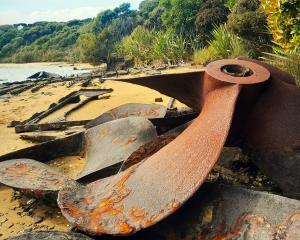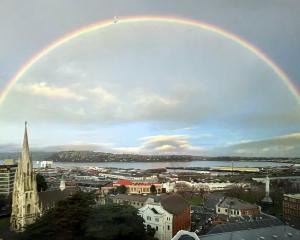The literary pretensions of an early Dunedin-based foray into publishing sank without trace, writes Michael Hamblyn.
Before ever there were in-flight magazines, there was Red Funnel.
The ''literary magazine'' was published between August 1905 and October 1909 by the Dunedin-based Union Steam Ship Company.
It leapt into existence seemingly fully fledged, thanks to the efforts of an American, Mr A. A. Brown, who became its editor and manager.
Sea voyages had their periods of tedium and times when passengers needed privacy and Red Funnel was full of short stories, serialised novels, true-to-life adventure stories, snippets of current affairs and jokes which could distract the bored passenger.
Also, the magazine described the company's ports of call around New Zealand, the Pacific Islands, Australia, the North Pacific and the western seaboards of North America and Canada.
Hopefully, casual readers ''at Home'', would read the magazine and be tempted to book holiday excursions on the company's steamers.
On December 21, 1904, the Otago Daily Times reported on a ''proposed new magazine''.
It reported that: ''The Union Steam Ship Company of New Zealand [Limited] is now engaged in the preliminary work incident to the publication of a high-class literary magazine, the initial number of which will appear about April next under the title of The Red Funnel. This is but another step made by this popular company to meet every demand of the public. The magazine, we are informed, will in no wise be a guide book or travellers hand book but will be contained exclusively to the varied literature that goes to the making of a popular magazine for the home, the club, the library, and for the traveller by rail or sea. It will maintain a dignity of character that will reflect the highest and noblest emotions of Australasian manhood and womanhood, and present to the world's readers a reflex of the life and aspirations of a people, altogether little known beyond the borders of their own land. Its contributing staff, it is stated, will be drawn from the ranks of the ablest writers, statesmen, educators, journalists, missionaries, travellers, and popular authors of fiction who will unite in making each issue a literary mirror, reflecting the brightest gems in the Australasian literary life.''
On July 11, 1905, a celebration was held to mark the inaugural edition of Red Funnel and the next day the Otago Daily Times wrote: ''a unique ceremony took place at the publishing department of Messrs J. Wilkie and Co., Vogel street [sic] yesterday afternoon, when the first number of the literary magazine, The Red Funnel, was published. Guests included Mr James Mills, managing director of the Union Steam Ship Company, Mr C. Holdsworth, the company's general manager and Mr A. A. Brown, the editor and manager of the magazine. Some idea of the commitment made by Wilkie and Co can be gained by the fact that ''for the purposes of the magazine, new Cottrell [American] and Payne [English] presses have been imported, and a new cutter, a stitching machine, revolving collator, and 1000lb of new type have also been obtained''.
Significant efforts had been made to find enough quantities of the right paper.
• Fifteen thousand copies were printed and priced at 6d each, sold at the company's wharf-side offices throughout New Zealand and on board their steamers.
The magazine flourished under the energetic editorship of Mr Brown for the next five years. Brown was an indefatigable traveller and ''booster'' of industry, wherever he found it.
He travelled around New Zealand and overseas (presumably by company steamer) soliciting articles from the regions and further afield.
In 1906, for instance, he addressed the Dunedin Progressive Society's meeting as a guest speaker in the Dunedin Trades' Hall where he delivered a lecture entitled ''Across the American Continent'', taking ''the audience with him from Boston right across to San Francisco, stopping at the principal cities and places of interest to describe the industries, some of huge dimensions like oil, iron, tool and canning''.
He also gave talks ''From Coast to Coast through Canada'', illustrated with lantern slides, the profits of which went to worthy causes such as the Free Kindergarten Schools in Dunedin.
The two English-born contributors whose work appeared in Red Funnel were the writer Edith A. Howes and the artist Robert Hawcridge.
Edith Howes (1872-1954) was an outstanding teacher, educationalist and writer.
She contributed about 30 stories to Red Funnel over five years.
Many were based on Maori myths and legends and they have been described (with all due respect to Howes) by Heather Murray as ''naïve''.
Her stories were aimed at children and adults would have read these fables to their off-spring.
Robert ''Bob'' Hawcridge (1866-1920) had illustrated brochures for the Union Steam Ship Company since at least 1889.
He illustrated many of the stories in Red Funnel for Edith Howes and other writers.
He was at one time director of the Otago Art School.
Red Funnel ceased publication in 1909.
It did not wither away, but vanished seemingly overnight.
Its passing attracted some comment from contemporary journalists.
A Wellington-based journalist, Frank Morton wrote: ''I hear that the Red Funnel magazine has ceased publication. There is nothing surprising in that. The magazine had a great opportunity, and fooled it away. Proof again, were proof needed, of how silly a great corporation may be, once it steps aside from the direct line of its business. If the Union Steam Ship Company had put the magazine into the hands of a capable man and left that capable man alone, the magazine must have succeeded. But the Company did nothing of a sort. It decided that the magazine must be edited to meet the whim of querulous old ladies in Dunedin. It secured an editor who, with many good qualities, had no more certain literary instincts than a cow. It made a shocking mess of the whole business.
''If you ever happen to come across the Sunset magazine of San Francisco, you may see how shrewdly the publicity department of a great corporation can conduct a magazine.
''So, Sunset succeeds and the Red Funnel might easily have succeeded. There is room in New Zealand for a good magazine of this type - a magazine that shall express the country without prejudice or colour of party. Most of the Tourist Department's literature is of no use on earth, unless it be as a soporific.''
In contrast, the popular magazine Freelance stated in 1909 that: ''The versatile A. A. Brown, who cut some ice in Dunedin a couple of years ago as a prominent insurance official with the Equitable, and afterwards started and edited the Red Funnel magazine, is now settled in Baker City, Oregon State. A. A. B. is now editing The Democrat, a daily of some pretensions in that city which flourishes with its 10,000 or so of population.
''An American visitor who happened into this office on Monday, states that the ex-Red Funnel scribe has lifted The Democrat out of the ordinary, and boomed it along to pretty prosperous music. A. A. Brown was always one for big strokes, but couldn't get the rope for it down Dunedin way. The element down there was possibly too pronounced canny for his American ideas. Now that he has got a fairly free hand, he's smothering the other journalistic enterprises in his district with the dust as he leaves them behind.''
• Michael Hamblyn is a Dunedin print historian.











